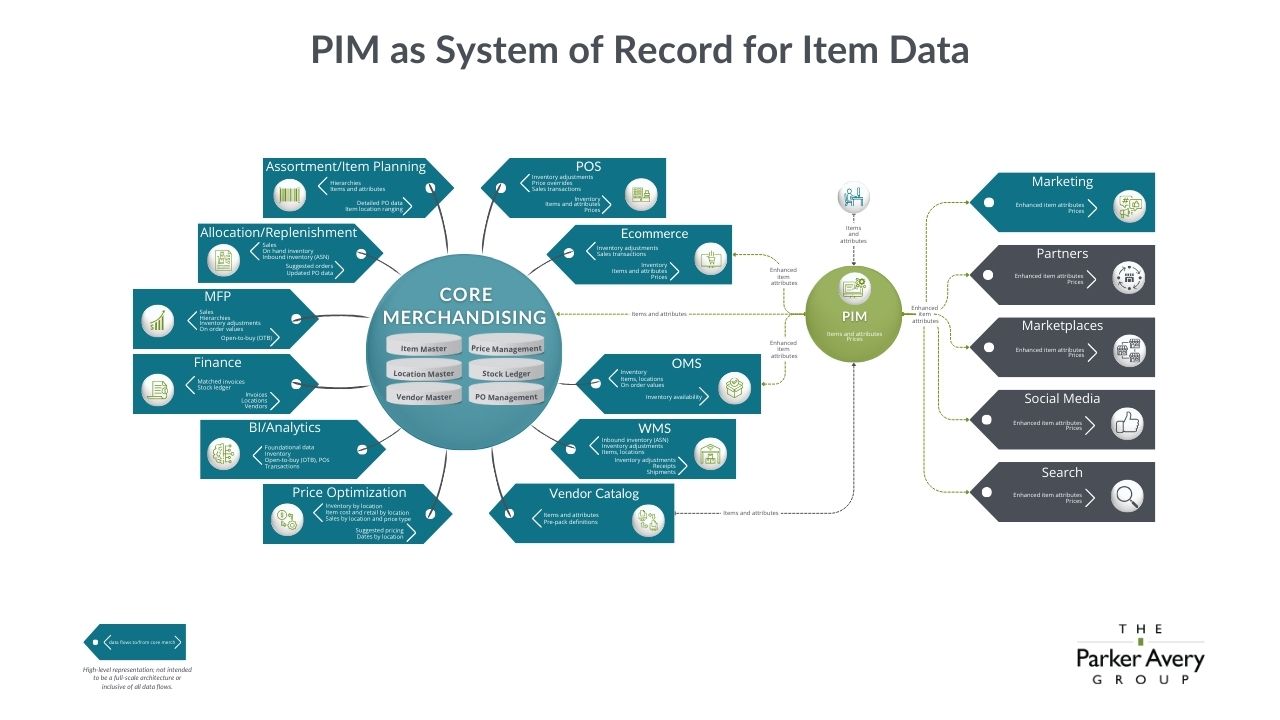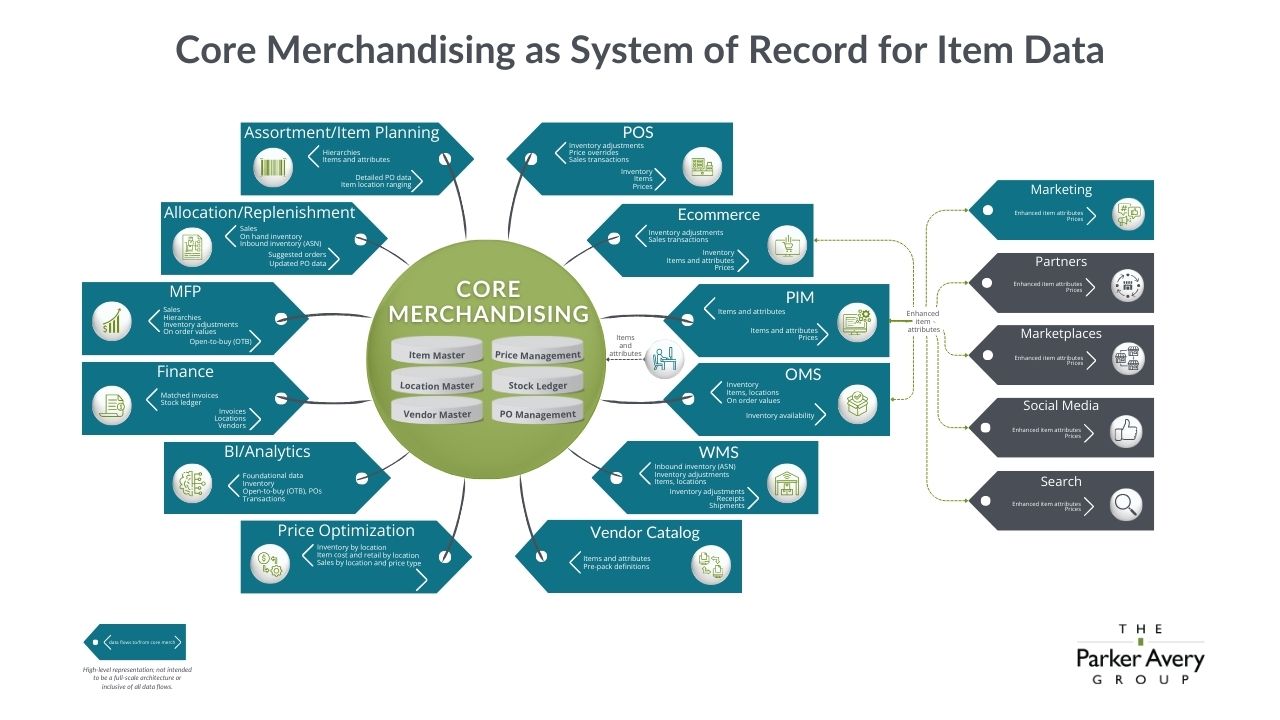Core Merchandising vs. PIM:
Which Solution is Right for Your Item Data?
In a retail or consumer packaged goods environment (CPG), the most critical piece of information is item or product data. With omnichannel retail models as the standard and increasing consumer appetite for more details about the products they purchase, item data has expanded to include much more comprehensive information than was traditionally captured in a core merchandising system. To efficiently support both customer expectations as well as internal business teams, items must be set up and managed properly in the appropriate application to support the organization.
In this post, we explore two major systems for setting up and managing items, what tool should be the system of record for item data, as well as the considerations for each path. The two major options are:
- Core Merchandising (core merch)
- Product Information Management (PIM)
Differences Between Core Merchandising and PIM
Before we get into the discussion of which tool serves as a better system of record for item data, let’s level-set the main differences between core merchandising and PIM systems.
Core merchandising refers to a suite of applications used by retailers to manage their products (items), locations, suppliers, inventory, purchasing (merchandise purchase orders) pricing, and promotions. It serves as a central hub for various merchandising, financial, and operational activities within a retail organization. In an ideal environment, core merchandising systems provide a common foundational data source for other retail systems, such as demand forecasting, planning, replenishment, allocation, warehouse management, finance, business intelligence, and reporting.
Much of a retailer’s product-related data is contained and managed in the core merchandising system, supporting buying, planning, financial, and operational business decisions. Core merchandising systems primarily support saleable products, but some systems provide basic functionality for non-saleable items (e.g., fixtures and supplies). Core merchandising systems also allow retailers to structure their data into efficient product, location, and vendor hierarchies for a variety of purposes.
Core merchandising refers to a suite of applications used by retailers to manage their products (items), locations, suppliers, inventory, purchasing (merchandise PO’s) pricing, and promotions.
A core merchandising system is used almost exclusively for internal purposes. Examples of data integrations with core merchandising include:
| Data | System |
|---|---|
| Sales, Returns | Allocation, Replenishment, BI/Analytics |
| Item Cost | Finance, Assortment Planning |
| Item Attributes | Planning, E-commerce, OMS |
| Units, Inventory | Allocation, Replenishment, POS, e-commerce, OMS |
| Price, Price History | Price Optimization, POS, E-commerce, Promotion Management |
| Purchase Orders, Receipts | Planning, Replenishment, Allocation, Invoice Match |
| Sizes and Size Variations | Size/Pack Optimization, Replenishment |
Product information management or PIM refers to a system used by businesses to manage and centralize information about their products. PIM is focused on sellable products only and does not include other foundational data about vendors, locations, etc. Data in a PIM includes details like enhanced item descriptions, images, specifications, and other relevant data. PIM systems help retailers maintain consistent and up-to-date product information across various sales channels, such as e-commerce websites, catalogs, and more.
PIM contains item data used by extended teams within an organization and external partners that supplement data found in a core merchandising system. These extended teams are mostly in the marketing organization and customer-facing partners.
Examples of data used and shared by a PIM include:
- Extended product descriptions (long names, detailed descriptions that are customer-facing and do not include acronyms that are used internally)
- Extended product attributes that are not specifically needed for merchandising decisions (country of origin, care instructions, language translations)
- Usable “tags” for:
- Creating decision trees for consumers to narrow down product selections (typically on the left side of a web page, where consumers can select/deselect characteristics such as ratings, vendor, dimensions, price ranges, colors, etc.)
- Improving external searches for products for SEO purposes or being included in images as clickable shopping options
- Complementary products within a website for add-on purchasing (e.g. when purchasing an air purifier, the related replacement filters would be included on the shopping page)
PIM contains item data used by extended teams within an organization and external partners that supplement data found in a core merchandising system.
Deciding Between PIM and Core Merchandising for Item Data System of Record
It is important to note that most advanced retailers would benefit from having both a modern core merchandising system and a PIM in place. As described above, core merchandising covers a much broader scope of data supporting a retailer’s functional and strategic planning environments, whereas PIM almost exclusively supports customer-facing item data.
Retailers who do not have a centralized tool for managing extended item attributes typically face significant inefficiencies and are at a higher risk of data errors due to the necessity of manual data entry into multiple disparate systems. As such, PIM is important for item data consistency and speed, particularly relative to external-facing systems.
The question is which should be the item data system of record. In other words: Where should the product data be created initially and maintained in the future?
For retailers in the market for technology to support a single version of the truth for item data, there are two main factors to consider:
- How item information will be used
- Implementation cost and effort
Let’s explore each of these components.
How Item Information Will Be Used
It is important to consider how item data changes will impact the flow of information and what downstream systems and processes will be impacted. The data needs to be accessible by other systems through data integration or data queries. The type of data needed by those downstream systems and processes determines if the information comes from PIM or core merchandising.
However, as with most data integration, item data does not follow a straight path but moves back and forth between both internal and external systems. Further, the frequency of data updates or synchronization must be considered. The question to ask is, “What is the most efficient path?” for the organization.
PIM as System of Record for Item Data
Figure 1 is an example of what integration may look like if PIM is the system of record.
In this scenario, where PIM is defined as the system of record for item maintenance, it would send item information required by the core merchandising system to support other internal processes. For example, product attributes that are set up and maintained in PIM would go through core merchandising to assortment planning to evaluate the products selected for that season.
As PIM data may not be complete or in the needed syntax for downstream systems, some data may need to be enriched in core merchandising before those data feeds. For example, item description fields in a core merch system are typically limited to fewer than 30 characters, so this information may need to be added (enriched) in the core merchandising system before creating purchase orders, running BI reports, or creating assortment and item plans.
If the purpose of the item data is solely to support marketing, e-commerce, and customer-facing content, PIM would be the choice.
Core Merchandising as System of Record for Item Data
In this example, item and attribute information is set up and maintained in the core merchandising system. Further, relevant data goes from operational and transactional systems to core merchandising, which consolidates and updates data and sends it to applications that need it.
Notice that the core merchandising systems are more comprehensive data stores for a retailer’s business-critical operational information. Location and vendor data necessary for merchandising capabilities (e.g., store clustering, vendor rebates, purchase order transmissions) is housed in core merchandising. In this scenario, the core merchandising system is a more holistic source of merchandising data than PIM.
As core merch is the central point for most downstream retail systems, it would edge out PIM as the stronger data source.
From a technical integration perspective, core merchandising systems offer the most streamlined path for creating and maintaining an item with the fewest “steps” to create and use the item.
Real-World Retail Example
A Parker Avery global client is planning to use PIM as their item setup mechanism yet wants the flexibility to create near-real-time purchase orders on new products for opportunistic buys. The risk in this approach is a potential integration lag creating challenges in the company’s ability to react quickly.
Implementation Cost and Effort
Core merchandising system implementations take longer and are typically more expensive because of the much larger scope of functionality and impact on the organization.
While PIM will not solve all item-data-related challenges, PIM implementations are typically much shorter and less expensive than core merchandising implementations (as they do not have as many dependent applications).
However, if a retailer’s core merchandising system no longer supports the organization or other applications, is built on antiquated technology, can no longer be maintained, or is being considered for replacement for other reasons, a company may decide to implement PIM as a stopgap. In this scenario, PIM could be used to assist in:
- Updates and reorganization of products (hierarchies and attributes)
- Improving the efficiency of communicating customer-facing information to marketing or digital platforms
If PIM is implemented first, implications on core merchandising data must be considered. For example, if implementing a PIM is going to result in a reorganization of the product hierarchy, the impact of reclassification on core merch and downstream systems must be considered to avoid repeating the exercise when the company implements a new core merchandising system.
Real-World Retail Example
Another Parker Avery client is planning to replace their core merchandising solution and does not plan to start the project for another year. Based on the complexity of their environment, their new core merchandising solution may not be fully rolled out for 24-30 months. The company also has several legacy applications for item setup and maintenance. Coupled with acquisitions, their data is disparate and fractured.
In this scenario, it may be worth investing in a PIM solution to help ensure that by the time they are ready to begin migrating data to their new core merch solution, they have clean, harmonized data. Some PIM vendors offer data cleansing as part of their implementation. This approach would not only help the company to achieve clean data, but it would also allow improvements in their digital marketing and ecommerce platforms with data that is specific to those channels.
Recapping the Core Merchandising vs. PIM Considerations
| Capabilities | Core Merchandising | PIM |
|---|---|---|
| Merchandising product information (attributes, status, etc.) | X | X |
| Product pricing information (store POS, eCommerce) | X | |
| Promotion management (not optimization) | X | |
| Inventory status for BOPIS, BOPAC, BOSFS, etc. | X | |
| Audited sales information | X | |
| Purchase order transmission and maintenance with vendors | X | |
| On order (open purchase orders) for planning (to calculate OTB) | X | |
| Inventory information for finance | X | |
| Invoice reconciliation and payment | X | |
| Provide support for planning (MFP, AP, IP) | X | |
| Provides customer-facing product information | X |
| High-Level Implementation Considerations | Core Merchandising | PIM |
|---|---|---|
| Cost to implement and maintain | Lower | |
| Expected duration of implementation | Faster* | |
| Training and sustainment | Easier |
* Does not account for pre-implementation data cleansing.
Final Word
While the benefits and constraints of both core merchandising and PIM solutions have been outlined, keep in mind that this is not a “one vs. the other” decision. Both systems can exist within a company’s data infrastructure as they serve different purposes. Based on what a retailer or CPG company is trying to accomplish, the decision of what path to take relative to the item data system of record does not have a simple answer.
Regardless of the approach, the specific business process and roles must be defined clearly, as well as collaboration and handoffs.
The bottom line is that item data and maintenance can be complex and there are multiple ways to manage this information. As discussions begin (or may already be in progress), retailers must ensure stakeholders are as knowledgeable as possible about the options, benefits, and impacts.
If you would like to have a conversation to help determine whether core merchandising or PIM is the right path for managing your item data, feel free to reach out to us.
You may also like







